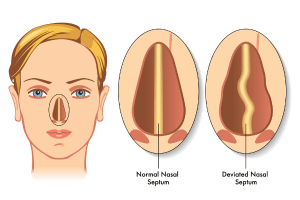Living with a deviated septum, an often overlooked yet remarkably common condition, is like having an unseen squatter in your own nose, stealthily disrupting your breathing. A crooked wall within your nose, a deviated septum, might sound innocuous, but when it begins to turn your peaceful slumber into a nightly struggle for air, its disruptive presence becomes undeniable.
In fact, this common condition can wreak havoc on your quality of life, sparking an array of symptoms ranging from breathing difficulties to recurrent sinus infections. But fear not – there’s a knight in shining armor ready to wage war against this silent invader: septoplasty in Los Angeles. This surgical intervention strides into the battlefield with a clear objective – to straighten the septum, restore balance, and reclaim your right to breathe freely.
Let’s delve deeper into this medical marvel, exploring the intricacies of septoplasty and how it battles the challenges of a deviated septum.
Pros of Septoplasty in Los Angeles
Imagine struggling to breathe freely through your nose, each inhalation feeling like a miniature tug-of-war, all thanks to an unseen foe hidden within your own nostrils – a deviated septum. Sounds like an unwelcome daily drama, doesn’t it? Now imagine a solution that could dramatically change that narrative: septoplasty.
Septoplasty is a remarkable procedure that steps onto this complicated terrain with a straightforward mission: to straighten your septum and restore the harmony of your nasal pathways. The septum, the wall that divides your nostrils, when deviated, can obstruct one or both nasal passages. This obstruction is often the root cause of the breathing difficulties experienced by many individuals.
1. Improved Breathing
The primary benefit of septoplasty is improved nasal breathing. A deviated septum can block one or both nostrils, making breathing through the nose difficult, especially during physical activities or sleep. By straightening the septum, septoplasty opens the nasal airway, significantly improving airflow and making breathing easier.
During septoplasty in Los Angeles, Dr. Cohen meticulously reshapes the septum and internal nasal architecture, meticulously maneuvering it back to its rightful position at the center to optimize airflow. Restoring the balance to the septum means that the air can flow freely again, bringing a breath of fresh relief to those who’ve long been gasping for it.
The real magic of septoplasty is in its transformative power. It’s not just about the enhancement of your breathing; it’s about the improvement of your quality of life. And for many, this breath of fresh air is more than just a physical relief; it’s a moment of reclaiming control, one inhale at a time.
2. Reduced Nasal Discomfort
Like an uninvited guest, a deviated septum can wreak havoc in your nasal passages, causing discomfort and persistent distress. Septoplasty is a game-changing procedure that shows this intruder the exit. By straightening the septum, septoplasty eases the pressure, reduces inflammation, and curbs recurrent nosebleeds. It’s a breath of fresh air – quite literally – transforming your nasal landscape into a comfortable, open space. It’s not just surgery, it’s a pathway to relief. Patients experience a substantial decrease in nasal discomfort and a marked improvement in their overall quality of life post-surgery.
3. Improved Sleep Quality
For those battling a deviated septum, every night can be an epic struggle, wrestling with snoring, sleep apnea, or the simple challenge of breathing comfortably. Septoplasty straightens the nasal septum, clearing the way for better airflow. The result? A drastic improvement in sleep quality. Imagine falling asleep to the rhythm of calm, unobstructed breathing instead of fighting for each breath. With septoplasty, this dream can become your reality – a symphony of serene nights and refreshing mornings.
The improved nasal airflow following septoplasty is a significant benefit for those suffering from sleep-related problems caused by a deviated septum. Conditions like sleep apnea, loud snoring, and insomnia can be reduced or even eliminated, leading to better sleep quality and, in turn, improved overall health.
4. Permanent Solution
Septoplasty offers a permanent solution to the problems caused by a deviated septum. Unlike other treatments like nasal strips or medications, which provide temporary relief, septoplasty addresses the root cause of the problem and provides long-lasting results. This surgical procedure doesn’t just address the symptoms; it tackles the root of the problem, straightening the septum and improving airflow.
It’s a one-time intervention with the potential for life-long results. With septoplasty, you’re not just buying a ticket to immediate relief; you’re investing in a future of unrestricted breathing. It’s not just a procedure, it’s a transformative journey towards lasting comfort.
Cons of Septoplasty
While septoplasty in Los Angeles is a game-changer for those with a deviated septum, it’s essential to navigate this path with open eyes, acknowledging the potential pitfalls along the journey. Like any surgical procedure, septoplasty carries risks that should be considered.
1. Surgical Risks
Embarking on the journey towards septoplasty can be likened to stepping into a brave new world of hope and promise for those wrestling with a deviated septum. But every adventure has its potential hazards, and septoplasty is no exception. This surgical intervention carries the inherent risks associated with any operation, such as reactions to anesthesia, bleeding, and infection. There’s also a chance of nasal discomfort, changes in the sense of smell, or even an altered nose shape.
It’s vital to weigh these risks against the potential benefits and discuss them thoroughly with your surgeon before deciding on your path forward.
2. Postoperative Discomfort
While septoplasty can be a game-changer for those with a deviated septum, it’s essential to navigate this path with open eyes, acknowledging the potential pitfalls along the journey. Like any surgical procedure, septoplasty carries risks, including bleeding, infection, or an adverse reaction to anesthesia.
Some patients might experience temporary numbness, discomfort, or even changes in their sense of smell. Moreover, there’s no absolute guarantee of perfection – slight deviations may remain, or new ones may occur due to natural changes or injuries. Therefore, it’s crucial to consider these factors and discuss them in detail with your healthcare provider.
Postoperative discomfort, including swelling, bruising, and temporary changes in sensation such as numbness or tingling, are common after septoplasty. Although these effects typically subside within a few weeks, they can cause significant temporary discomfort.
3. No Guarantee of Symptom Relief
There’s no guarantee that septoplasty will completely relieve symptoms, especially if other conditions, such as allergies or chronic sinusitis, contribute to them. While most patients experience significant symptom improvement, some may see only a minor change or, in rare cases, no change at all. It’s a reminder that each body is unique, and responding differently to treatment interventions.
4. Potential for Revision Surgery

In some cases, the initial septoplasty may not effectively correct the septum, or new trauma may cause a new septal deviation. These scenarios could require a revision surgery, adding to the patient’s financial burden and recovery time.
Key Takeaways
In conclusion, septoplasty can significantly improve the quality of life for those with a deviated septum, offering enhanced breathing, reduced nasal discomfort, improved sleep, and providing a permanent solution. However, potential patients must weigh these benefits against the possible surgical risks, postoperative discomfort, the chance that symptoms may not be fully alleviated, and the potential need for revision surgery. Also, the lack of a guaranteed outcome emphasizes the need for open dialogue and informed decision-making in the patient’s healthcare journey.
If you’re tired of struggling to breathe due to a suspected deviated septum, contact a board-certified septoplasty surgeon to discuss the pros and cons of septoplasty before making an informed decision. Remember, your septoplasty treatment plan and outcome are unique and dependent on various factors, including the severity of the septal deviation, overall health, and the presence of other nasal or sinus conditions.

